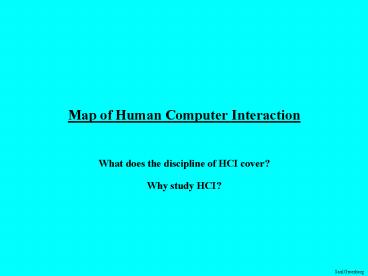Map of Human Computer Interaction - PowerPoint PPT Presentation
1 / 11
Title:
Map of Human Computer Interaction
Description:
Human-machine fit and adaptation. improve the fit between the ... space shuttles, super tankers) help control consumer equipment (cars, washing machines) ... – PowerPoint PPT presentation
Number of Views:104
Avg rating:3.0/5.0
Title: Map of Human Computer Interaction
1
Map of Human Computer Interaction
- What does the discipline of HCI cover?
- Why study HCI?
2
Overview Map of Human Computer Interaction
Use and Context
Human-Machine Fit and Adaptation
Social Organization and Work
Application Areas
Human
Computer
Computer
Dialogue
Graphics
Techniques
Human
Information
A a
Processing
Dialogue
Dialogue
Language,
Architecture
Genre
Communication
Input and
Output Devices
Ergonomics
and Interaction
Example Systems
Evaluation
Implementation
and Case Studies
Techniques
Techniques and Tools
Design
Approaches
Development Process
3
Use and context of computers
- Problems of fitting computers, their uses, and
the context of use together - Social organization and work
- humans are interacting social beings
- considers models of human activity
- small groups, organizations, socio-technical
systems - quality of work life
- Application areas
- characteristics of application domains, e.g.
individual vs group work - popular styles
- document production, communications, design,
tutorials and help, multi-media information
kiosks, continuous control (cockpits, process
control), embedded systems (copiers, home
appliances) - Human-machine fit and adaptation
- improve the fit between the designed object and
its use - how systems are selected and adopted how users
improvise routine systems how systems adapt to
the user (customization) how users adapt to the
system (training, ease of learning) user
guidance (help, documentation, error-handling)
4
(No Transcript)
5
Human characteristics
- To understand the human as an information-processi
ng system, how humans communicate, and peoples
physical and psychological requirements - Human information processing
- characteristics of the human as a processor of
information - memory, perception, motor skills, attention,
problem-solving, learning and skill acquisition,
motivation, conceptual models, diversity... - Language, communication and interaction
- aspects of language
- syntax, semantics, pragmatics conversational
interaction, specialized languages - Ergonomics
- anthropometric and physiological characteristics
of people and their relationship to workspace and
the environment - arrangement of displays and controls cognitive
and sensory limits effects of display
technology fatigue and health furniture and
lighting design for stressful and hazardous
environments design for the disabled...
6
Computer system and interface architecture
- The specialized components computers have for
interacting with people - Input and output devices
- mechanics and characteristics of particular
hardware devices, performance characteristics
(human and system), esoteric devices, virtual
devices - Dialogue techniques
- the basic software architecture and techniques
for interacting with humans - e.g. dialog inputs and outputs interaction
styles issues - Dialog genre
- The conceptual uses to which the technical means
are put - e.g. interaction and content metaphors,
transition management, style and aesthetics - Computer graphics
- basic concepts from computer graphics that are
especially useful to HCI - Dialogue architecture
- software architecture and standards for
interfaces - e.g., screen imaging window managers interface
toolkits multi-user architectures, look and
feel, standardization and interoperability
7
The Development Process
- The construction and evaluation of human
interfaces - Design approaches
- the process of design
- e.g. graphical design basics (typography, color,
etc) software engineering task analysis
industrial design... - Implementation techniques and tools
- tactics and tools for implementation, and the
relationship between design, evaluation and
implementation - e.g. prototyping techniques, dialog toolkits,
object-oriented methods, data representation and
algorithms - Evaluation techniques
- philosophy and specific methods for evaluation
- e.g. productivity, usability testing, formative
and summative evaluation - Example systems and case studies
- classic designs to serve as example of interface
design genres
8
Why study human use of computer systems?
- Business view
- to use humans more productively/effectively
- the human costs now far outweigh hardware and
software costs - Personal view
- people view computers as appliances, and want it
to perform as one - Marketplace view
- everyday people using computers
- now expect easy to use system
- not tolerant of poorly designed systems
- little vendor control of training
- heterogeneous group
- if product is hard to use, people will seek other
products - eg Mac vs IBM (Microsoft Windows)
9
Why study human use of computer systems?
- The system view
- complex human
- complex computer
- complex interface between the two
- The human factors view
- humans have necessary limitations
- errors are costly in terms of
- loss of time
- loss of money
- loss of lives in critical systems
- loss of morale
- design can cope with such limitations!
10
Why study human use of computer systems?
- The social view
- Computers contribute to critical parts of our
society, and cannot be ignored - educate our children
- take medical histories and provide expert advice
- keep track of our credit worthiness
- play(?) war games (and help form policies)
- control air and ground traffic flow
- book travel
- control chemical/oil/nuclear plants
- control space missions
- assist humans with their everyday tasks (office
automation) - control complex machines (aircraft, space
shuttles, super tankers) - help control consumer equipment (cars, washing
machines) - entertainment (games, intellectual
stimulation).In all these views, economics and
human best interests are aligned
11
You know now
- The HCI discipline includes the study of
- the use and context of computers
- human characteristics
- computer system and interface architecture
- the development process
- HCI is worth studying because it aligns both
human interests and economic interests































